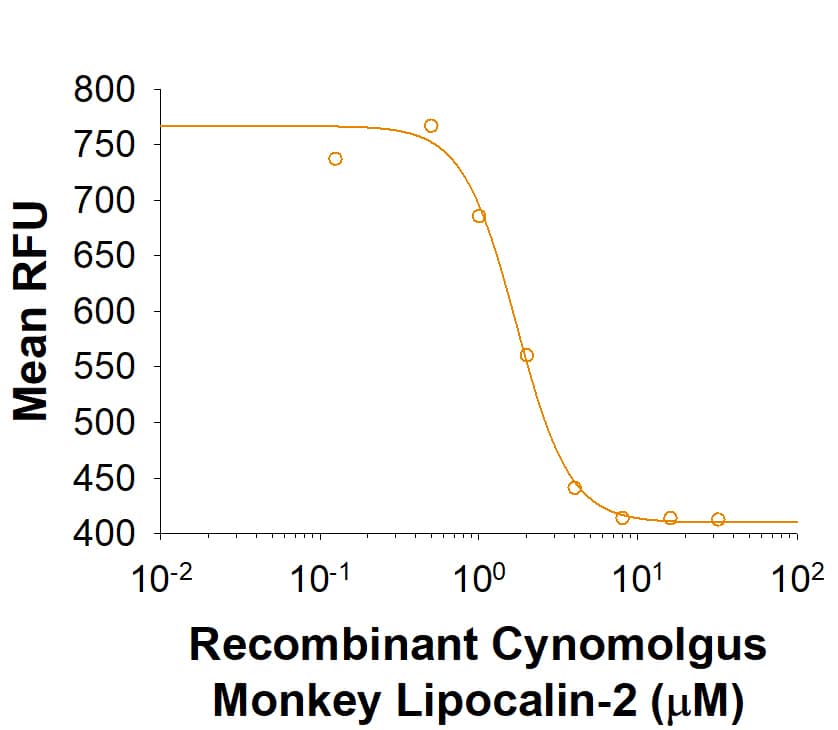Recombinant Cynomolgus Lipocalin-2/NGAL His-tag Protein, CF
R&D Systems, part of Bio-Techne | Catalog # 2357-LC

Key Product Details
Product Specifications
Source
Chinese Hamster Ovary cell line, CHO-derived cynomolgus monkey Lipocalin-2/NGAL protein
Gln21-Gly198
with C-terminal 6-His tag
Gln21-Gly198
with C-terminal 6-His tag
Purity
>95%, by SDS-PAGE visualized with Silver Staining and quantitative densitometry by Coomassie® Blue Staining.
Endotoxin Level
<0.10 EU per 1 μg of the protein by the LAL method.
N-terminal Sequence Analysis
No results obtained. Gln21 is inferred from enzymatic pyroglutamate treatment revealing Asp22.
Predicted Molecular Mass
21 kDa
SDS-PAGE
21-27 kDa, reducing conditions
Activity
Measured by its ability to bind Iron(III) dihydroxybenzoic acid [Fe(DHBA)3]. The binding of Fe(DHBA)3 results in the quenching of Trp fluorescence in Lipocalin-2.
>1.0 μM of Fe(DHBA)3 can be bound under the described conditions.
>1.0 μM of Fe(DHBA)3 can be bound under the described conditions.
Scientific Data Images for Recombinant Cynomolgus Lipocalin-2/NGAL His-tag Protein, CF
Recombinant Cynomolgus Lipocalin-2/NGAL His-tag Protein Binding Activity
Recombinant Cynomolgus Monkey Lipocalin-2 (Catalog # 2357-LC) is measured by its ability to bind Iron(III) dihydroxybenzoic acid.Recombinant Cynomolgus Lipocalin-2/NGAL His-tag Protein SDS-PAGE
2 μg/lane of Recombinant Cynomolgus Monkey Lipocalin‑2/NGAL was resolved with SDS-PAGE under reducing (R) and non-reducing (NR) conditions and visualized by Coomassie® Blue staining, showing a primary band at 24 kDa under reducing conditions.Formulation, Preparation and Storage
2357-LC
| Formulation | Supplied as a 0.2 μm filtered solution in MES and NaCl. |
| Shipping | The product is shipped with polar packs. Upon receipt, store it immediately at the temperature recommended below. |
| Stability & Storage | Use a manual defrost freezer and avoid repeated freeze-thaw cycles.
|
Background: Lipocalin-2/NGAL
References
- Flower, D. R. et al. (1994) FEBS Lett. 354:7.
- Kjeldsen L. et al. (2000) Biochim. Biophys. Acta. 1482:272.
- Goetz, D. H. et al. (2002) Mol. Cell 10:1033.
- Flo, T. H. et al. (2004) Nature 432:917.
- Yang, M. B. et al. (2002) Mol. Cell. 10:1045.
- Ferreira, A. C. et al. (2018) Neurosci. BioBehav. Rev. 95:73.
- Devireddy, L. R. et al. (2001) Science 293:829.
- Jung, M. et al. (2017) Front. Immunol. 8:1171.
- Hanai, J. et al. (2005) J. Biol. Chem. 280:13641.
- Mori, K. et al. (2005) J. Clin. Invest. 115:610.
- Sun, W. Y. et al. (2018) JCI Insight. 3:120196.
- Zhou, F. et al. (2016) Eur. J. Cardiothorac. Surg. 49:746.
Long Name
Neutrophil Gelatinase-associated Lipocalin
Alternate Names
24p3, LCN2, Lipocalin2, MSFI, NGAL, Oncogene 24p3, p25, Siderocalin, Uterocalin
Gene Symbol
LCN2
UniProt
Additional Lipocalin-2/NGAL Products
Product Documents for Recombinant Cynomolgus Lipocalin-2/NGAL His-tag Protein, CF
Product Specific Notices for Recombinant Cynomolgus Lipocalin-2/NGAL His-tag Protein, CF
For research use only
